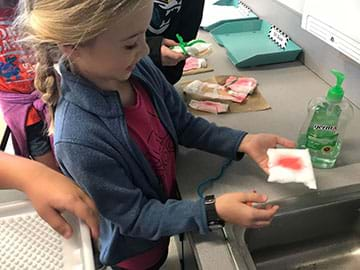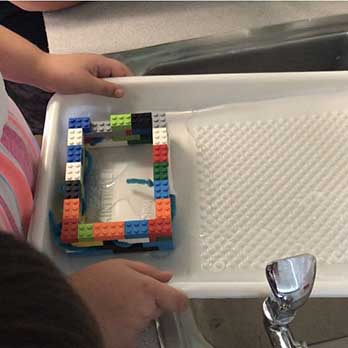Quick Look
Grade Level: Elementary school
Time Required: 45 minutes (wild guess!)
Subject Areas: Physical Science, Problem Solving

Maker Challenge Recap
In this maker challenge, students follow the engineering design process and use water-absorbing crystals to create a bandage that can be used in a traumatic situation, like a car accident or hiking accident. Students first observe how water-absorbing crystals work and then consider how their function could be applied in a medical setting. Later, students design a new bandage while following a budget as well as some constraints. In conclusion, students discuss whether or not their design would be effective in the real world.
Maker Materials & Supplies
- bag of water-absorbing crystals; available at home improvement stores or online (See Resources below)
- water
- red food coloring
- masking tape
- medical gauze (2 squares per group)
- eyedropper
- paint tray (optional)
- pipe cleaners
- medical tape (approximately 15 cm per group)
Worksheets and Attachments
Visit [www.teachengineering.org/makerchallenges/view/uof-2496-bandage-water-absorbing-crystals-design-challenge] to print or download.Subscribe
Get the inside scoop on all things TeachEngineering such as new site features, curriculum updates, video releases, and more by signing up for our newsletter!More Curriculum Like This

Students employ the engineering design process to create a device that uses water-absorbing crystals for use during a flood or storm surge. They use (or build) a toy house, follow the engineering design process to build their device, and subject the house to tests that mimic a heavy flood or rising ...

Students learn about various crystals, such as kidney stones, within the human body. They also learn about how crystals grow and ways to inhibit their growth. They also learn how researchers such as chemical engineers design drugs with the intent to inhibit crystal growth for medical treatment purpo...
Kickoff
Background Information
Water-absorbing crystals are polymers that, when exposed to water, form hydrogels. Hydrogels have many practical applications, such as use in contact lenses and diapers. In agricultural applications, hydrogels added to soils allow for larger and more efficient crop yields that use less water. Researchers are also discovering more ways to use hydrogels in medical settings, such as in the treatments of wounds or burns.
With the Students
Water-absorbing crystal observation protocol:
Have students observe the water-absorbing crystals prior to beginning this activity. See below for an example of the protocol:
- Instruct students to first write down or draw what they know about what happens when they (or someone they know) gets a cut. What is the process to stop a cut from bleeding?
- Each student should have a workstation with a paper towel, an eyedropper, a small cup of water, and a water-absorbing crystal.
- Ask the students to observe the water-absorbing crystal and have students write or draw what they see in their lab books.
- Instruct students to drop a small amount water onto the crystal with the eyedropper until they notice a change. The water crystal will absorb water and become soft and squishy. Again, ask the students to describe what they see in their lab notebooks. Have students describe how these crystals could be used in a bandage.
- Next, have the students place their entire water-absorbing crystal into the cup of water so that it is completely submerged. Ask students for their predictions as to what will happen to the size, texture, or shape of the crystal after it soaks in the water for 10 minutes.
- After 10 minutes, have students take the crystal out of the cup. Ask them to describe their observations in their notebooks.
Kickoff
Getting a cut or a burn on the body is never fun. Large cuts can lead to more blood loss, which can cause serious problems for a patient. In a major accident, seconds can make all the difference. If a normal bandage will not help prevent blood loss in a serious situation, can you use the engineering design process to build a better bandage?
Resources
- Refer to the Engineering Design Process hub on TeachEngineering to guide your students through the challenge.
- Utilize the Engineering Design Process Notebook, as students work though the design process.
- Read the resource Stopping Bleeding from Healthline and consider sharing some of the information for the class. The American Red Cross also has good information on major injuries due to blood loss, including how to assist a patient in the event of a major accident.
- Steve Spangler Science sells a kit with water-absorbing crystals. While this is not necessary to completion of this activity, the website has helpful tips and videos for working with hydrogels.
Maker Time
Give students the materials and instruct them to create a bandage that will stop blood loss. The bandage should be able to hold three eyedroppers’ worth of “blood” (red food coloring) in order to be considered successful. The bandage must be made in $10 or less, as described in the budget section and it must prevent blood from flowing onto the ground or floor.
Give the students 30 minutes to build their device. Have students test their device by squirting three eyedroppers’ worth of water (colored red with food coloring, if desired) onto the bandage. Discuss the success or failure of each design, and then allow time for redesign.
Budget:
- Masking tape - $2 per 30 cm piece
- Blood - $0
- Paint tray/container - $0
- Pipe cleaners - $4 each
- Water absorbing crystals - $5 per teaspoon
- Medical gauze - $3 per square
- Medical tape - $2 per 15 cm piece
Wrap Up
After the students finish their testing and designs, have them reflect on their process.
- Did their bandage work? What worked best and what didn’t work so well?
- Is there a way to determine if this design is the “best” design possible?
- How might you need to change this design to use in the real world on a person?
- How can you define success in this activity? Is any amount of blood dripping from the bandage acceptable?
Tips
- Follow the water-absorbing crystal protocol to help students understand how the water-absorbing crystals work before beginning.
- Test the bandages over a sink or large plastic container for easier cleanup.
- Make sure the students understand that they should be testing the bottom of the bandage (the part that would touch the skin), not the top.
Copyright
© 2019 by Regents of the University of Colorado; original © 2019 University of FloridaContributors
Mackenzie McNickleSupporting Program
Multidisciplinary Research Experiences for Teachers of Elementary Grades, Herbert Wertheim College of Engineering, University of FloridaAcknowledgements
This curriculum was based upon work supported by the National Science Foundation under RET grant no. EEC 1711543— Engineering for Biology: Multidisciplinary Research Experiences for Teachers in Elementary Grades (MRET) through the College of Engineering at the University of Florida. Any opinions, findings, and conclusions or recommendations expressed in this material are those of the authors and do not necessarily reflect the views of the National Science Foundation.
Last modified: June 9, 2021







User Comments & Tips